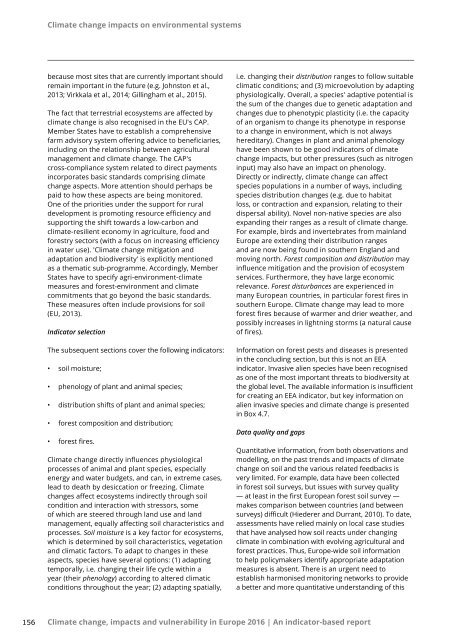Climate change impacts and vulnerability in Europe 2016
document
document
Create successful ePaper yourself
Turn your PDF publications into a flip-book with our unique Google optimized e-Paper software.
<strong>Climate</strong> <strong>change</strong> <strong>impacts</strong> on environmental systems<br />
because most sites that are currently important should<br />
rema<strong>in</strong> important <strong>in</strong> the future (e.g. Johnston et al.,<br />
2013; Virkkala et al., 2014; Gill<strong>in</strong>gham et al., 2015).<br />
The fact that terrestrial ecosystems are affected by<br />
climate <strong>change</strong> is also recognised <strong>in</strong> the EU's CAP.<br />
Member States have to establish a comprehensive<br />
farm advisory system offer<strong>in</strong>g advice to beneficiaries,<br />
<strong>in</strong>clud<strong>in</strong>g on the relationship between agricultural<br />
management <strong>and</strong> climate <strong>change</strong>. The CAP's<br />
cross‐compliance system related to direct payments<br />
<strong>in</strong>corporates basic st<strong>and</strong>ards compris<strong>in</strong>g climate<br />
<strong>change</strong> aspects. More attention should perhaps be<br />
paid to how these aspects are be<strong>in</strong>g monitored.<br />
One of the priorities under the support for rural<br />
development is promot<strong>in</strong>g resource efficiency <strong>and</strong><br />
support<strong>in</strong>g the shift towards a low-carbon <strong>and</strong><br />
climate-resilient economy <strong>in</strong> agriculture, food <strong>and</strong><br />
forestry sectors (with a focus on <strong>in</strong>creas<strong>in</strong>g efficiency<br />
<strong>in</strong> water use). '<strong>Climate</strong> <strong>change</strong> mitigation <strong>and</strong><br />
adaptation <strong>and</strong> biodiversity' is explicitly mentioned<br />
as a thematic sub-programme. Accord<strong>in</strong>gly, Member<br />
States have to specify agri-environment-climate<br />
measures <strong>and</strong> forest-environment <strong>and</strong> climate<br />
commitments that go beyond the basic st<strong>and</strong>ards.<br />
These measures often <strong>in</strong>clude provisions for soil<br />
(EU, 2013).<br />
Indicator selection<br />
The subsequent sections cover the follow<strong>in</strong>g <strong>in</strong>dicators:<br />
• soil moisture;<br />
• phenology of plant <strong>and</strong> animal species;<br />
• distribution shifts of plant <strong>and</strong> animal species;<br />
• forest composition <strong>and</strong> distribution;<br />
• forest fires.<br />
<strong>Climate</strong> <strong>change</strong> directly <strong>in</strong>fluences physiological<br />
processes of animal <strong>and</strong> plant species, especially<br />
energy <strong>and</strong> water budgets, <strong>and</strong> can, <strong>in</strong> extreme cases,<br />
lead to death by desiccation or freez<strong>in</strong>g. <strong>Climate</strong><br />
<strong>change</strong>s affect ecosystems <strong>in</strong>directly through soil<br />
condition <strong>and</strong> <strong>in</strong>teraction with stressors, some<br />
of which are steered through l<strong>and</strong> use <strong>and</strong> l<strong>and</strong><br />
management, equally affect<strong>in</strong>g soil characteristics <strong>and</strong><br />
processes. Soil moisture is a key factor for ecosystems,<br />
which is determ<strong>in</strong>ed by soil characteristics, vegetation<br />
<strong>and</strong> climatic factors. To adapt to <strong>change</strong>s <strong>in</strong> these<br />
aspects, species have several options: (1) adapt<strong>in</strong>g<br />
temporally, i.e. chang<strong>in</strong>g their life cycle with<strong>in</strong> a<br />
year (their phenology) accord<strong>in</strong>g to altered climatic<br />
conditions throughout the year; (2) adapt<strong>in</strong>g spatially,<br />
i.e. chang<strong>in</strong>g their distribution ranges to follow suitable<br />
climatic conditions; <strong>and</strong> (3) microevolution by adapt<strong>in</strong>g<br />
physiologically. Overall, a species' adaptive potential is<br />
the sum of the <strong>change</strong>s due to genetic adaptation <strong>and</strong><br />
<strong>change</strong>s due to phenotypic plasticity (i.e. the capacity<br />
of an organism to <strong>change</strong> its phenotype <strong>in</strong> response<br />
to a <strong>change</strong> <strong>in</strong> environment, which is not always<br />
hereditary). Changes <strong>in</strong> plant <strong>and</strong> animal phenology<br />
have been shown to be good <strong>in</strong>dicators of climate<br />
<strong>change</strong> <strong>impacts</strong>, but other pressures (such as nitrogen<br />
<strong>in</strong>put) may also have an impact on phenology.<br />
Directly or <strong>in</strong>directly, climate <strong>change</strong> can affect<br />
species populations <strong>in</strong> a number of ways, <strong>in</strong>clud<strong>in</strong>g<br />
species distribution <strong>change</strong>s (e.g. due to habitat<br />
loss, or contraction <strong>and</strong> expansion, relat<strong>in</strong>g to their<br />
dispersal ability). Novel non-native species are also<br />
exp<strong>and</strong><strong>in</strong>g their ranges as a result of climate <strong>change</strong>.<br />
For example, birds <strong>and</strong> <strong>in</strong>vertebrates from ma<strong>in</strong>l<strong>and</strong><br />
<strong>Europe</strong> are extend<strong>in</strong>g their distribution ranges<br />
<strong>and</strong> are now be<strong>in</strong>g found <strong>in</strong> southern Engl<strong>and</strong> <strong>and</strong><br />
mov<strong>in</strong>g north. Forest composition <strong>and</strong> distribution may<br />
<strong>in</strong>fluence mitigation <strong>and</strong> the provision of ecosystem<br />
services. Furthermore, they have large economic<br />
relevance. Forest disturbances are experienced <strong>in</strong><br />
many <strong>Europe</strong>an countries, <strong>in</strong> particular forest fires <strong>in</strong><br />
southern <strong>Europe</strong>. <strong>Climate</strong> <strong>change</strong> may lead to more<br />
forest fires because of warmer <strong>and</strong> drier weather, <strong>and</strong><br />
possibly <strong>in</strong>creases <strong>in</strong> lightn<strong>in</strong>g storms (a natural cause<br />
of fires).<br />
Information on forest pests <strong>and</strong> diseases is presented<br />
<strong>in</strong> the conclud<strong>in</strong>g section, but this is not an EEA<br />
<strong>in</strong>dicator. Invasive alien species have been recognised<br />
as one of the most important threats to biodiversity at<br />
the global level. The available <strong>in</strong>formation is <strong>in</strong>sufficient<br />
for creat<strong>in</strong>g an EEA <strong>in</strong>dicator, but key <strong>in</strong>formation on<br />
alien <strong>in</strong>vasive species <strong>and</strong> climate <strong>change</strong> is presented<br />
<strong>in</strong> Box 4.7.<br />
Data quality <strong>and</strong> gaps<br />
Quantitative <strong>in</strong>formation, from both observations <strong>and</strong><br />
modell<strong>in</strong>g, on the past trends <strong>and</strong> <strong>impacts</strong> of climate<br />
<strong>change</strong> on soil <strong>and</strong> the various related feedbacks is<br />
very limited. For example, data have been collected<br />
<strong>in</strong> forest soil surveys, but issues with survey quality<br />
— at least <strong>in</strong> the first <strong>Europe</strong>an forest soil survey —<br />
makes comparison between countries (<strong>and</strong> between<br />
surveys) difficult (Hiederer <strong>and</strong> Durrant, 2010). To date,<br />
assessments have relied ma<strong>in</strong>ly on local case studies<br />
that have analysed how soil reacts under chang<strong>in</strong>g<br />
climate <strong>in</strong> comb<strong>in</strong>ation with evolv<strong>in</strong>g agricultural <strong>and</strong><br />
forest practices. Thus, <strong>Europe</strong>-wide soil <strong>in</strong>formation<br />
to help policymakers identify appropriate adaptation<br />
measures is absent. There is an urgent need to<br />
establish harmonised monitor<strong>in</strong>g networks to provide<br />
a better <strong>and</strong> more quantitative underst<strong>and</strong><strong>in</strong>g of this<br />
156 <strong>Climate</strong> <strong>change</strong>, <strong>impacts</strong> <strong>and</strong> <strong>vulnerability</strong> <strong>in</strong> <strong>Europe</strong> <strong>2016</strong> | An <strong>in</strong>dicator-based report


